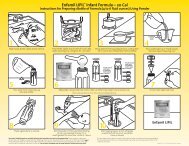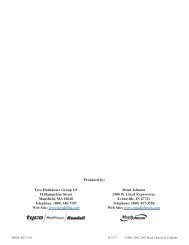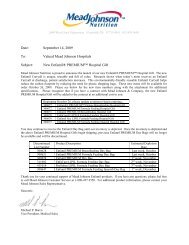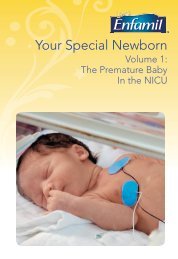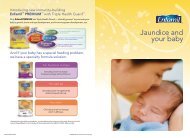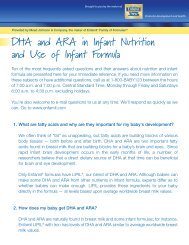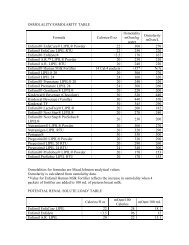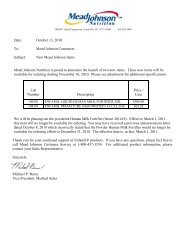LB2882MaternalNutriti+ - Mead Johnson Nutrition
LB2882MaternalNutriti+ - Mead Johnson Nutrition
LB2882MaternalNutriti+ - Mead Johnson Nutrition
Create successful ePaper yourself
Turn your PDF publications into a flip-book with our unique Google optimized e-Paper software.
FOOD SAFETY ISSUES<br />
Fish and Seafood<br />
Seafood is an easy-to-prepare food that is rich in protein, vitamins, and minerals, and relatively low in total and<br />
saturated fat. Fish and shellfish also supply LCPUFA, most notably DHA, that play a role in the development of the<br />
fetal and infant brain and retina.<br />
Fish and shellfish, however, are also potential sources of methyl mercury and other neurotoxic contaminants. 35<br />
Exposure to high levels of such contaminants during gestation increases the risk for suboptimal neurodevelopment of<br />
children. Levels of neurotoxic contaminants in fish vary widely among regions of the world. Therefore, it is important<br />
to check with national and regional authorities for information on the levels of contaminants found in fish consumed in<br />
that region and for recommendations on fish consumption. 35<br />
According to the US Food and Drug Administration (FDA) and the US Dietary Guidelines for Americans 2010, women<br />
in their childbearing years should avoid swordfish, tilefish, king mackerel, and shark because of their high methyl<br />
mercury content. In addition, women should eat no more than 12 ounces (about 340 grams) of low-mercury fish and<br />
shellfish weekly, such as trout, salmon, pollock, catfish, canned light tuna, canned sardines, shrimp, crab, scallops,<br />
and herring, and limit albacore (“white”) tuna intake to 6 ounces weekly as part of the 12-ounce limit. 36,37 Women who<br />
eat fish caught for sport should first check the safety of the rivers, lakes, and streams where the fish has been caught<br />
with local or state health authorities.<br />
Even with all the caveats, it is likely that the benefits of consuming low-risk seafood outweigh the potential harm to<br />
a developing fetus and to maternal health. 132 Maternal intake of low-risk seafood during pregnancy helps to optimize<br />
neurodevelopment in children. 132-134<br />
Foodborne Pathogens<br />
Pregnant women run a greater risk for foodborne illness from pathogens that can threaten maternal and fetal health. 38<br />
For example, pregnant women are more likely to develop listeriosis if exposed to Listeria monocytogenes. 135 Infection<br />
with Toxoplasma gondii from eating undercooked, contaminated meat and/or from contact with contaminated<br />
cat feces can be transmitted to a fetus and can cause severe illness. 136 Table 12 summarizes common foodborne<br />
pathogens that may harm a pregnant woman or her fetus.<br />
Adequate hand washing and proper food handling can significantly reduce the risk of foodborne illness. 38 There is<br />
no evidence to suggest that organic foods, which are produced with no synthetic pesticides, synthetic fertilizers,<br />
antibiotics, growth hormones and other drugs, offer complete protection from foodborne pathogens.<br />
25







